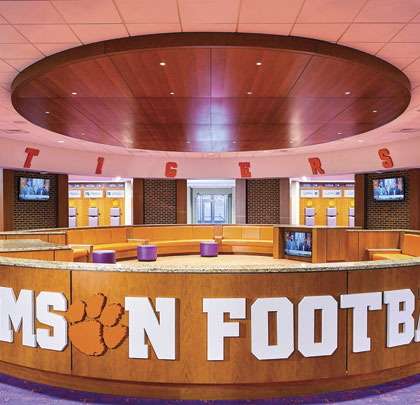Clemson University recently constructed a new state-of-the-art home for its 2016 NCAA championship football team and was able to rethink conventional wisdom with a radical, more flexible approach to fire code interpretations. Let’s continue with part two of the article and how aspirating technology took center stage.
ASPIRATING TECHNOLOGY
In smoke detection, advanced technologies such as the VEA provide earlier warning by aspirating—or drawing in air—from each room through small, flexible tubing. The air is then analyzed to identify the presence of minute smoke particles in a continuous process.
This is in stark contrast with the way traditional smoke detectors are designed. Conventional detectors are typically installed in each room or common space and connected to a central fire alarm panel by low voltage electrical wiring. When a significant amount of smoke accumulates in the chamber of the smoke detector, the alarm sounds.
“The VEA allowed us to get an earlier warning to the occupants, which allowed them to move earlier and fully egress the building in less time than the prescriptive alarm initiation requirements,” says Mike Ernst, senior fire protection engineer at Jensen Hughes.
“By going to a performance-based design and [aspirating technology], egress is faster and the building safer than if we followed the prescriptive code,” agrees Paul Borick, one of Clemson University’s Capital Projects project managers for renovations and new construction.
BETTER AIR SAMPLING
The technology was first introduced in the early 1980s by Xtralis as the VESDA (Very Early Smoke Detection Apparatus) system. The company now offers a VEA model that consists of small, unobtrusive sample points in each room. The air is analyzed using sophisticated laser-based technology at the central unit located within 300 feet.
As a multi-channel, addressable system, the central unit can pinpoint the exact location of the alarm. A single system supports up to 40 sample points and can be extended to 120.
The system is also sophisticated enough to allow for three levels of sensitivity that can significantly reduce false alarms. For example, the system can differentiate a fire alarm triggered by someone smoking in a room from an alarm activated by a smoldering fire.
EASE OF MAINTAINING
Even with these benefits, one of the primary advantages of an aspirating smoke detector system is its ease of maintenance, inspection, and servicing.
While spot smoke detectors are reliable and relatively easy to install, NFPA regulations also mandate annual inspection and testing of each unit for many facilities including colleges and universities. This tedious and time-consuming process requires a fire alarm contractor to enter each room, introduce smoke directly into the detector and verify that it functions properly. This is often covered under ongoing maintenance contracts where fire alarm contractors make a significant amount of their profit.
According to Ernst, the aspirating technology significantly simplifies such annual smoke detector maintenance.
“Maintenance-wise, you have a few VEA detectors with about 160 sampling points in this building [that can be tested from a central location each year], which is a lot simpler,” says Ernst. Traditionally, that would have required about 160 spot smoke detectors to be tested every year at varying heights and locations, including some 20-30 feet off the ground, such as the weight room.”
“The ultimate goal in any collegiate environment is safety, getting people out of the building quickly in case of a fire,” concludes Borick. “In that regard, by following performance-based design, I think we have created a much safer environment for our student-athletes in this new facility than if we followed the prescriptive code. While our project may be the first to use this design method in South Carolina, I soon expect a slew of such projects may also consider this method on campuses nationwide.”
For more information:
For more information about Xtralis, call 619.252.2015, or visit www.xtralis.com/vea.
_________________________________________________________________________
Modern Contractor Solutions, April 2018
Did you enjoy this article?
Subscribe to the FREE Digital Edition of Modern Contractor Solutions magazine.



